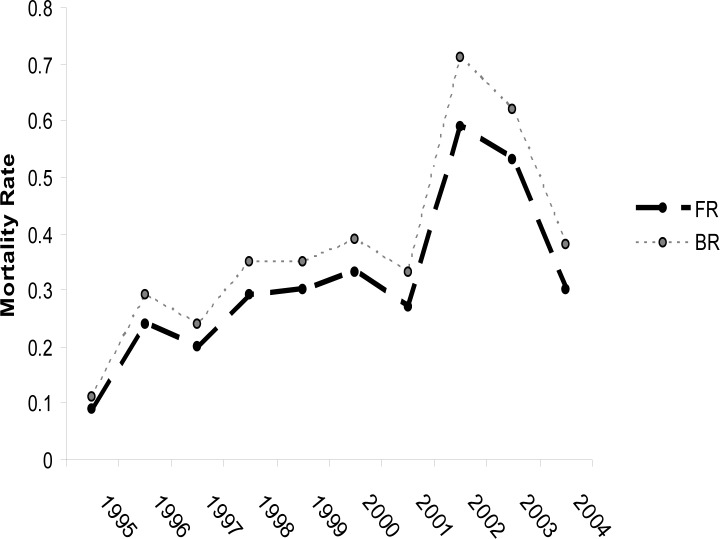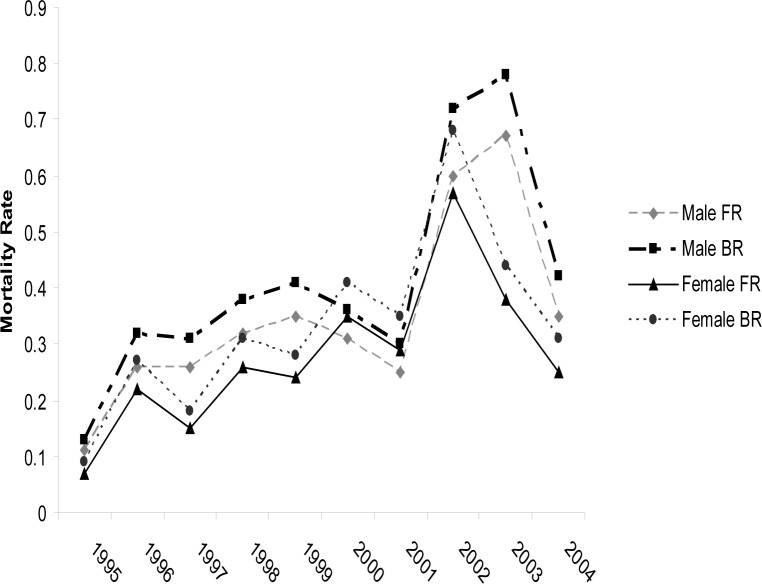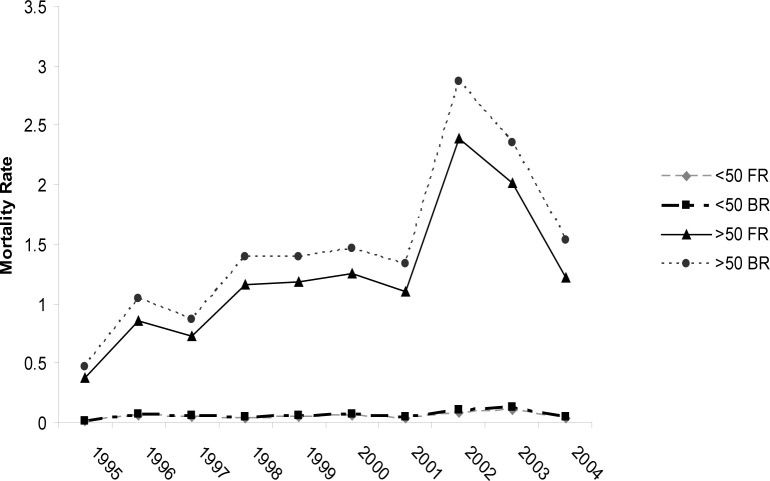Abstract
Aim
The aim of this study is to estimate oral cavity cancer mortality for Iranian population, using Bayesian approach in order to revise this misclassification.
Background
Mortality is a familiar projection to address the burden of cancers, but according to Iranian death registry, about 20% death statistics were still recorded in misclassified categories.
Patients and methods
We analyzed national death statistic reported by the Iranian Ministry of Health and Medical Education from 1995 to 2004 stratified by age group, sex, and cause of death are included in this analysis. Oral cavity cancer [ICD-10; C00-08] were expressed as the annual mortality rates/100,000, overall, by sex and by age group (<50 and ≥50 years of age) and age standardized rate (ASR). The Bayesian approach to correct and account for misclassification effects in Poisson count regression with a beta prior employed to estimate the mortality rate of EC in age and sex group.
Results
According to the Bayesian re-estimate there were between 20 to 30 percent underreported mortality records in death due to oral cavity cancer. The age standardized mortality rate of oral cavity cancer increased dramatically during these years, Age specific rate for oral cavity cancer indicated higher mortality rate for older age.
Conclusion
Our findings suggested a substantial undercount of oral cavity cancer mortality in Iranian population. So policy makers who determine research and treatment priorities on death rates should notice to this underreported data.
Keywords: Oral cavity cancer, Mortality, Bayesian analysis
Introduction
The gastrointestinal (GI) cancers are the most frequent cancer among Iranians (1, 2) and the burden of these cancers were increased recently (3–5).
Oral cavity cancer is the eighth most frequent cancer among men in the world (6).
It is estimated that 34,360 new cases of pharyngeal and oral cavity cancer would be diagnosed in 2007 in the United States and that 7550 people will die from these cancers (7). In Taiwan, oral cancer has been one of the leading causes of death from cancer since 1991 (8). Neoplasms at the lip, oral cavity and oropharynx represent about 1.5% of the total neoplasms in Japan (9).
Mortality is a familiar projection to address the burden of cancers (10). But this aim needs reliable death registry systems which reports death statistics annually. On the other hand the analysis of death statistic subject to misclassification is a major problem in epidemiological analysis leading to biases estimates, and can therefore cause one to underestimate health risks (11). According to Iranian death registry, between 15% to 20% death statistics were recorded in misclassified categories such as septicemia, senility without mention of psychosis symptoms, unknown cancers and other ill-defined conditions, etc (12).
In statistical literature two approaches recommended for misclassification. First is using a small validation sample (13) and the second is Bayesian analysis in which subjective prior information on at least some subset of the parameters used to re-estimate death statistic (14, 15).
Though, the information on mortality of oral cavity cancer has been studied in some developed countries, data from developing countries like Iran is still scantly. The aim of this study is to re-estimate oral cavity cancer mortality rate for Iranian population, using Bayesian approach.
Patients and Methods
National death statistic reported by the MOH&ME from 1995 to 2000 (registered death statistics for Iranian population at the Information Technology and Statistic Management Center, MOH&ME) and from 2001 to 2004 (published by MOH&ME) (12, 16, 17) stratified by age group, sex, and cause of death are included in this analysis. Oral cavity cancer [ICD-10; C00-08] were expressed as the annual mortality rates/100,000, overall, by sex and by age group (<50 and ≥50 years of age) and age standardized rate (ASR). The populations of Iran in 1995-2004 were estimated, using the census from 1996 conducted by Statistics Centre of Iran and its estimation according to population growth rate for years before and after national census.
The Bayesian approach which considered here derived from models proposed by Stamey et al to correct and account for misclassification in a Poisson regression (11). Stamey's technique extended the model recently proposed to overcome the problem of misclassification in cancer data (14, 15) and Pourhoseingholi et al developed this technique to estimate mortality rate of GI cancers (2, 4, 18). We studied Iranian death statistic in a Bayesian poisson regression using Stamey's approach to re-estimate mortality rate of oral cavity cancer. The misclassification probability estimate which is proposed in prior distribution was based on Iranian death registration which introduced up to 20% misclassified records in total deaths and a beta prior assumed to re-estimate death statistic from misclassified groups. All analysis performed by a Macro, developed in S-Plus.
Results
All death records due to oral cavity cancer from 1995 to 2004 are included in this study. The rate of oral cavity cancer mortality classified by sex and age, generated from original database (Frequentist rate) and their Bayesian corresponding projections (Bayesian rate) appeared in Table 1 and Table 2.
Table 1.
Age standardized rate (per 100,000) for oral cavity mortality stratified by sex group before and after adjusting for misclassification by Bayesian model
| Year | Male | Female | Total | |||
|---|---|---|---|---|---|---|
| FR | BR | FR | BR | FR | BR | |
| 1995 | 0.11 | 0.13 | 0.07 | 0.09 | 0.09 | 0.11 |
| 1996 | 0.26 | 0.32 | 0.22 | 0.27 | 0.24 | 0.29 |
| 1997 | 0.26 | 0.31 | 0.15 | 0.18 | 0.20 | 0.24 |
| 1998 | 0.32 | 0.38 | 0.26 | 0.31 | 0.29 | 0.35 |
| 1999 | 0.35 | 0.41 | 0.24 | 0.28 | 0.30 | 0.35 |
| 2000 | 0.31 | 0.36 | 0.35 | 0.41 | 0.33 | 0.39 |
| 2001 | 0.25 | 0.30 | 0.29 | 0.35 | 0.27 | 0.33 |
| 2002 | 0.60 | 0.72 | 0.57 | 0.68 | 0.59 | 0.71 |
| 2003 | 0.67 | 0.78 | 0.38 | 0.44 | 0.53 | 0.62 |
| 2004 | 0.35 | 0.42 | 0.25 | 0.31 | 0.30 | 0.38 |
FR: Frequentist rate, BR: Bayesian rate
Table 2.
Age specific rate (per 100,000) for oral cavity cancer mortality before and after adjusting for misclassification by Bayesian model
| Year | <50 Years | > = 50 Years | ||
|---|---|---|---|---|
| FR | BR | FR | BR | |
| 1995 | 0.01 | 0.01 | 0.38 | 0.47 |
| 1996 | 0.06 | 0.07 | 0.86 | 1.04 |
| 1997 | 0.05 | 0.06 | 0.73 | 0.87 |
| 1998 | 0.04 | 0.05 | 1.16 | 1.39 |
| 1999 | 0.05 | 0.06 | 1.18 | 1.39 |
| 2000 | 0.06 | 0.07 | 1.25 | 1.46 |
| 2001 | 0.04 | 0.05 | 1.1 | 1.34 |
| 2002 | 0.08 | 0.1 | 2.39 | 2.87 |
| 2003 | 0.11 | 0.13 | 2.01 | 2.35 |
| 2004 | 0.04 | 0.05 | 1.22 | 1.53 |
FR: Frequentist Rate, BR: Bayesian Rate
According to the Bayesian re-estimate there were between 20 to 30 percent underreported mortality records in death due to oral cavity cancer (Figure 1).
Figure 1.
Trends of oral cavity cancer mortality during the period 1995-2004 (Age standardized rate per 100,000 FR: Frequentist rate, BR: Bayesian rate)
The age standardized mortality rate of oral cavity cancer increased dramatically during these years (Figure 1 and Table 1), however a sharp decreasing was observed from 2002 to 2004. Moreover the mortality of oral cavity cancer was higher for male except from 2000-2002 in which, the rate of female's death was close to male's or ranked it (Table 1 and Figure 2).
Figure 2.
Trends of oral cavity cancer mortality during the period 1995-2004 by sex groups (Age standardized rate per 100,000 FR: Frequentist rate, BR: Bayesian rate)
Besides, age specific rate for oral cavity cancer indicated higher mortality rate for older age (Table 2 and Figure 3).
Figure 3.
Trends of oral cavity cancer mortality during the period 1999-2004 (Age specific rate per 100,000 FR: Frequentist rate, BR: Bayesian rate)
Discussion
This study provides comprehensive projection for burden of death due to oral cavity cancer, based on the Iranian death registry system, indicating that the trend of its mortality was dramatically increased at the beginning of the 21 century and then stabilized after this increasing. Also our results indicated that up to 40% of mortality due to oral cavity cancer remains underreported and suggested a substantial undercount of its mortality in Iranian population. Mortality data, extracted from the world health organization (WHO) database showed that for both males and females, age-standardized rates mortality of oral cavity cancer in China (Hong Kong) were high and have decreased apparently over the period, whereas the mortality rates in the USA and Australia showed a decreasing trend throughout the observation period (1990–2006) (19).
Mortality rates in the USA, Australia and Asian countries except China (Hong Kong) were at the same level (19).
Our study revealed that although there was an increasing trend for mortality of oral cavity cancer, the rate of its death is still lower than other Asian.
In Iranian Death Registration System, data on causes of death are collected from various sources and have been assessed to be about 80% complete (20) and there is still up to 20% undefined death records that categorized as misclassification.
Recently Bayesian approach received much attention in the case of misclassification. Like Whittemore and Gong study on cervical cancer mortality (14), Sposto et al study on non-cancer and cancer mortality (15), and Pourhoseingholi et al studies on GI cancer mortality (2, 4, 18).
In conclusion, this study provides comprehensive projection for burden of death due to EC based on the national death registry, indicating that the trend of EC mortality was dramatically increased in recent decade
In conclusion, this study provides comprehensive projection for burden of death due to oral cavity cancer based on the death registry system for Iran, indicating that the trend of its mortality was increased in recent decade and then would be leveled off. Besides, there is a substantial undercount of oral cavity cancer mortality, according to the Bayesian model. So healthcare policy makers who determine research and treatment priorities on death rates as an indicator of burden of disease should notice to this underreported data.
However the burden of oral cavity cancer in Iran is lower than other Asian countries, further studies are required to establish risk factors or modifiers for this cancer in Iranian population.
Acknowledgments
This study was sponsored by the National Elite Foundation, Iran.
(Please cite as: Pourhoseingholi MA, Vahedi M, Baghestani AR, Abadi A. Bayesian correction for mortality trend of oral cavity cancer. Gastroenterol Hepatol Bed Bench 2012;5(Suppl. 1):S8-S12.).
References
- 1.Pourhoseingholi MA, Vahedi M, Moghimi-Dehkordi B, Pourhoseingholi A, Ghafarnejad F, Maserat E, Safaee A, et al. Burden of hospitalization for gastrointestinal tract cancer patients - results from a cross-sectional study in Tehran. Asian Pac J Cancer Prev. 2009;10:107–10. [PubMed] [Google Scholar]
- 2.Pourhoseingholi MA, Faghihzadeh S, Hajizadeh E, Abadi A, Zali MR. Bayesian estimation of colorectal cancer mortality in the presence of misclassification in Iran. Asian Pac J Cancer Prev. 2009;10:691–94. [PubMed] [Google Scholar]
- 3.Pourhoseingholi1 MA, Faghihzadeh S, Hajizadeh E, Abadi A. Years of life lost due to colorectal cancer in Iran. Gastroenterol Hepatol Bed Bench. 2010;3:187–89. [Google Scholar]
- 4.Pourhoseingholi MA, Fazeli Z, Zali MR, Alavian SM. Burden of hepatocellular carcinoma in iran; bayesian projection and trend analysis. Asian Pac J Cancer Prev. 2010;11:859–62. [PubMed] [Google Scholar]
- 5.Pourhoseingholi MA, Faghihzadeh S, Hajizadeh E, Gatta G, Zali MR, Abadi AR. Trend Analysis of Gastric Cancer and Colorectal Cancer Mortality in Iran, 1995-2003. Iran J Cancer Prev. 2011;1:38–43. [Google Scholar]
- 6.Ferlay J, Bray F, Pisani P, Parkin DM. Lyon: IARC Press; 2004. Globocan 2002 cancer incidence, mortality and prevalence worldwide. IARC [2.0], IARC Cancer Base No. 5. [Google Scholar]
- 7.Jemal A, Siegel R, Ward E, Lin JC, Murray T, Xu J, Thun MJ. Cancer statistics, 2007. CA Cancer J Clin. 2007;57:43–66. doi: 10.3322/canjclin.57.1.43. [DOI] [PubMed] [Google Scholar]
- 8.Liu SA, Tsai WC, Wong YK, Lin JC, Poon CK, Chao SY, et al. Nutritional factors and survival of oral cancer patients. Head Neck. 2006;28:998–1007. doi: 10.1002/hed.20461. [DOI] [PubMed] [Google Scholar]
- 9.Japan: Ministry of Health; 2005. Ministry of Health, Labour and Welfare. “MHLW” report. [Google Scholar]
- 10.Burnet NG, Jefferies SJ, Benson RJ, Hunt DP, Treasure FP. Years of life lost (YLL) from cancer is an important measure of population burden – and should be considered when allocating research funds. Br J Cancer. 2005;92:241–45. doi: 10.1038/sj.bjc.6602321. [DOI] [PMC free article] [PubMed] [Google Scholar]
- 11.Stamey JD, Young DM, Seaman JW., Jr A Bayesian approach to adjust for diagnostic misclassification between two mortality causes in Poisson regression. Stat Med. 2008;27:2440–52. doi: 10.1002/sim.3134. [DOI] [PubMed] [Google Scholar]
- 12.Naghavi M, editor. 1st edition. Tehran, Iran: Ministry of Health and Medical Education; 2004. Death report from 29 provinces in Iran. [Google Scholar]
- 13.Lyles RH. A note on estimating crude odds ratios in case–control studies with differentially misclassified exposure. Biometrics. 2002;58:1034–36. doi: 10.1111/j.0006-341x.2002.1034_1.x. [DOI] [PubMed] [Google Scholar]
- 14.Whittemore AS, Gong G. Poisson regression with misclassified counts: application to cervical cancer mortality rates. J R Stat Soc Ser C Appl Stat. 1991;40:81–93. [PubMed] [Google Scholar]
- 15.Sposto R, Preston DL, Shimizu Y, Mabuchi K. The effect of diagnostic misclassification on non-cancer and cancer mortality dose–response in A-bomb survivors. Biometrics. 1992;48:605–17. [PubMed] [Google Scholar]
- 16.Naghavi M, editor. 1st edition. Tehran, Iran: Ministry of Health and Medical Education; 2002. Death report from 18 provinces in Iran. [Google Scholar]
- 17.Naghavi M, editor. 1st edition. Tehran, Iran: Ministry of Health and Medical Education; 2003. Death report from 23 provinces in Iran. [Google Scholar]
- 18.Pourhoseingholi MA, Faghihzadeh S, Hajizadeh E, Abadi A. Bayesian analysis of gastric cancer mortality in Iranian population. Gastroenterol Hepatol Bed Bench. 2010;3:15–18. [Google Scholar]
- 19.Yako-Suketomo H, Matsuda T. Comparison of time trends in lip, oral cavity and pharynx cancer mortality (1990-2006) between countries based on the WHO mortality database. Jpn J Clin Oncol. 2010;40:1118–19. doi: 10.1093/jjco/hyq202. [DOI] [PubMed] [Google Scholar]
- 20.Khosravi A, Taylor R, Naghavi M, Lopez AD. Mortality in the Islamic Republic of Iran, 1964-2004. Bull World Health Organ. 2007;85:607–14. doi: 10.2471/BLT.06.038802. [DOI] [PMC free article] [PubMed] [Google Scholar]





